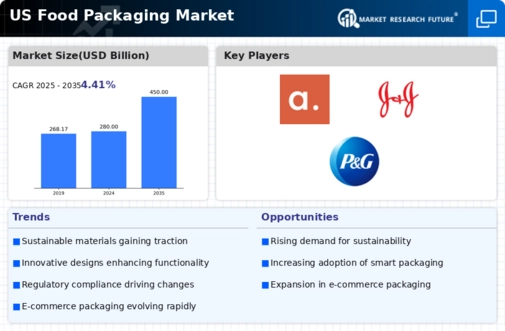Health and Safety Regulations
The food packaging market is significantly influenced by stringent health and safety regulations imposed by government agencies. These regulations are designed to ensure that packaging materials are safe for food contact and do not leach harmful substances into food products. Compliance with these regulations is crucial for manufacturers, as non-compliance can lead to product recalls and legal repercussions. In 2025, it is estimated that compliance costs could represent up to 15% of total packaging expenses for food manufacturers. As a result, the food packaging market is compelled to invest in safer materials and innovative designs that meet regulatory standards while also appealing to health-conscious consumers.
Rising Demand for Convenience Foods
The food packaging market is experiencing a notable surge in demand for convenience foods, driven by changing consumer lifestyles. As more individuals seek quick and easy meal solutions, manufacturers are increasingly focusing on packaging that enhances product accessibility and usability. This trend is reflected in the growth of ready-to-eat meals and snack foods, which require innovative packaging solutions to maintain freshness and extend shelf life. In 2025, the convenience food segment is projected to account for approximately 30% of the overall food packaging market, indicating a significant shift in consumer preferences. The food packaging market must adapt to these evolving demands by developing packaging that not only preserves food quality but also aligns with the fast-paced lifestyles of modern consumers.
Technological Advancements in Packaging
Technological advancements are playing a pivotal role in shaping the food packaging market. Innovations such as biodegradable materials, active packaging, and smart labeling are becoming increasingly prevalent. These technologies not only enhance the functionality of packaging but also address environmental concerns. For instance, the introduction of biodegradable plastics is projected to grow by 20% annually, reflecting a shift towards more sustainable practices. Furthermore, smart packaging technologies that provide real-time information about product freshness are gaining traction among consumers. The food packaging market must continue to embrace these advancements to remain competitive and meet the evolving expectations of consumers.
E-commerce Growth and Packaging Adaptation
The rapid growth of e-commerce is significantly impacting the food packaging market, necessitating adaptations in packaging design and materials. As online grocery shopping becomes more prevalent, packaging must ensure product integrity during transit while also being visually appealing for consumers. In 2025, it is projected that e-commerce will account for over 25% of food sales, driving the need for packaging that can withstand shipping conditions. The food packaging market is therefore tasked with developing robust, lightweight, and cost-effective packaging solutions that cater to the unique challenges posed by e-commerce logistics.
Consumer Preference for Sustainable Practices
The food packaging market is witnessing a growing consumer preference for sustainable practices, which is reshaping packaging strategies across the industry. As awareness of environmental issues increases, consumers are actively seeking products with eco-friendly packaging. In 2025, it is anticipated that approximately 40% of consumers will prioritize sustainability when making purchasing decisions. This shift is prompting manufacturers to explore alternative materials and reduce plastic usage. The food packaging market is thus challenged to innovate and implement sustainable solutions that not only meet consumer demands but also contribute to environmental conservation efforts.














Leave a Comment